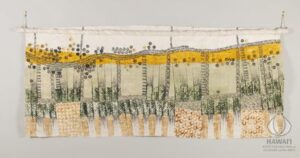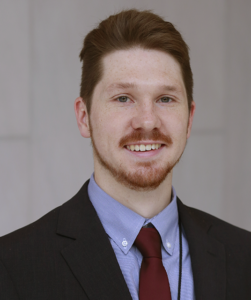June 7, 2023
Hawaiʻi: Supporting Native Hawaiians in Public Art

Roen Huffard, Citiscape, Kapa, 2020. This Kapa artwork is a recent Art in Public Places acquisition that stems from statewide outreach prioritizing Kapa artists that began in 2010. Photo courtesy Hawaiʻi State Foundation on Culture and the Arts
Public art programs are a powerful strategy that state arts agencies employ to encourage public appreciation of the arts, enliven public space, strengthen community identity, and engage and support artists from all backgrounds. The Hawaiʻi State Foundation on Culture and the Arts (SFCA) has undertaken a series of steps to ensure that its Art in Public Places program—the first statewide percent for art program in the nation—supports the full diversity of Hawaiʻi’s artistic community and acquires works of art expressive of the Hawaiian islands and the multicultural heritages of its people.
SFCA’s Art in Public Places (APP) program was started in 1967 and amended in 1990 to allow for the purchasing of works of art. The legislated one percent of capital construction allocates approximately $4 million in funding for the program per year. To evaluate the reach of the program, SFCA partnered with three Kānaka (Native Hawaiian) artists and curators in 2020 to provide a mixed curation and critical examination of its current collection of artwork. The curators noted in their curatorial statement that the Art in Public Places collection serves as the most significant public collection of modern and contemporary art of Hawaiʻi, but its historical practices focusing on predominantly Western and Asian artists underrepresented the works of Native Hawaiians.
Strengthened by the curatorial statement’s findings, SFCA continues to increase the visibility and acquisition of works by Native Hawaiians. the agency undertook a complement of strategies, including:
- inculcating an agency culture dedicated to community work and engagement;
- hiring Kānaka artists and curators at the Hawai’i State Art Museum to continue to engage with the Native Hawaiian artwork in the APP collection;
- expanding and diversifying the locations of exhibitions and juried shows from which SFCA acquires artwork;
- making it easier to invite the APP program’s Acquisition Award Selection Committee to consider works of art for acquisition.
SFCA also connects its folk and traditional arts grant programming to the APP program. For example, in 2018 the agency contracted with the North Kohala Community Associated to support a Kamehameha Day Celebration with the Hulu Preservation Society. As part of this traditional art project, HSFCA was able to assist in the conservation of the Kamehameha I statue. This networking promotes a nexus between the two programs that lifts up the work of Native Hawaiians and facilitates the restoration and purchase of Native Hawaiian artwork.
Ultimately, these actions work to break down what SFCA describes as the “arbitrary line” that is historically drawn between traditional and contemporary art—a line that has so often kept Native Hawaiian practitioners from representation in the APP program. A 2022 SFCA report to the state legislature highlighted the recent progress made by the agency and the impact of supporting Native Hawaiians through the APP program: From just 2020-2022, SFCA has increased its percentage of total works by Native Hawaiians from 3.9% to 18.3% and has purchased nearly $1.5 million in Native Hawaiian art. Contact SFCA Interim Executive Director and Art in Public Places Director Karen Ewald to learn more.
In this Issue
From the President and CEO
State to State
- Nebraska and Tennessee: Folk and Traditional Arts Programs
- Oregon: Arts and Culture Caucus
- Hawaiʻi: Supporting Native Hawaiians in Public Art
Legislative Update
The Research Digest
Announcements and Resources
More Notes from NASAA
SubscribeSubscribe
×
To receive information regarding updates to our newslettter. Please fill out the form below.

